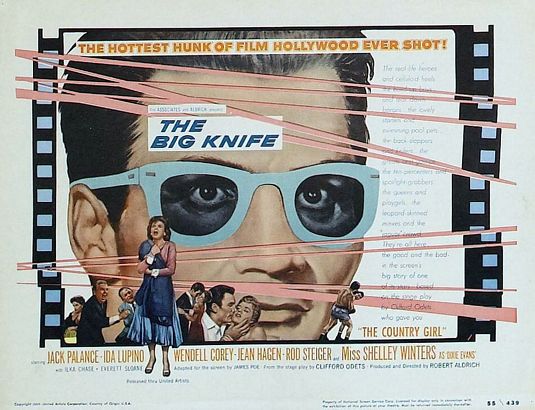The Big Knife is labelled a film noir by some. I don’t see it myself. Rather an overwrought pot-boiler.
A melodrama about Hollywood that out-melodramas Hollywood. Cloister an ensemble of A-list actors in a Hollywood bungalow with maverick-director Robert Aldrich, all singing from an operatic song-sheet courtesy of a play from Clifford Odets, with some snappy camera moves, amidst the hot-house boundaries of a posh living room, and the histrionics hit the roof.
Jack Palance a contract actor for an exploitative b-studio was once a young man with ideals. He is now a middle-aged drunkard and Lothario who still loves his estranged wife – an aging Ida Lupino who at all times seems rather lost and discomfited. She will only come back if he junks his career by refusing to sign a new contract pushed on to him by literally insane studio boss Rod Steiger. Wendell Corey a modern-day Iago is spin-artist to Steiger, and a man happy to contrive a murder to keep the lid on a damaging back-story.
Filmed with a flatness and harsh lighting that washes out any nuance or ambivalence, the players are left to strut their stuff with exaggerated gestures and contrived rhetoric. The picture may just as well have played as a radio soap. It is hard to conceive that the same director had just completed the great Kiss Me Deadly. One of the rare occasions I can agree with the NY Times’ Bosley Crowther, who on the film’s release saw “a group of sordid people jawing at one another violently”.


The post title is accurate. I’ve tried twice to get through this movie and could never get past the middle. It’s a shame since I like much of the talent involved.
LikeLike
Yes Diandra, a hard movie to get through, and with so much acting potential.
Btw, thanks for the link from your Blog, which I have just become aware of. A good read. I have placed a link on my sidebar.
Tony
LikeLike
Tony, I did think Steiger was quite effective, and Palance turned in an impressive performance as well. But I agree this film is undistinguished and ultimately unmemorable.
Keal says:
“It’s in the same garish genre as THE BAD AND THE BEAUTIFUL. It’s paced too fast and pitched too high; immorality is attacked with almost obscene relish, the knife turns into a buzz saw. Maybe because all these faults of taste you can’t take your eyes of it.”
Well, I don’t really have any desire to see it again, and your superb review makes no contrary case. Ha!
LikeLike
Funny Sam, I thought Steiger was such a ham in this. But from other reviews I gather his character is a composite of the big shot Hollywood producers of the period, and it may be that the drama queen portrayal is accurate after all!
LikeLike
Didn’t care for it either, visually boring also.
LikeLike
Tony, I only saw your reply now. Thanks!
LikeLike
I love The Big Knife. Crowther was an idiot–I read his review. You’re all wrong.
LikeLike
Cheers Peter. Promoting your book? There are better ways…
LikeLike
I agree this is NOT FILM NOIR…. the only similarity is in the darkness and shadows of the storyline… but any cinematographer world balk at the thought that there was “film noir” lighting and staging in this slow moving movie.
LikeLike
It may interest you to know that Rod Steiger was close friends with James Dean right around the time he shot this film, and in the final days of Dean’s life, he handed Steiger a copy of Ernest Hemingway’s “Death In The Afternoon” with anything pertaining to a bullfighter’s demise in the ring underlined by Dean’s hand numerous times. It’s also intensely resonant, if not downright chilling, to discover that the initial first showing of “The Big Knife” took place at The Venice Film Festival in Italy on September 10, 1955, a mere 20 days before Dean died.
Knowing this, the film suddenly leaves the realm of camp or dated melodrama, and cuts much more deeply in ways than anyone may have previously realized.
LikeLike
Thanks Johnny for this background. Certainly ironic.
LikeLike
Mr. D’ Ambra: Thank you for your kind reply. Something further for you to meditate upon, in regards to James Dean and “The Big Knife”….a car accident is at the center of
the film’s blackmail and cover-up plot. Odets may have been florid, but he was never superficial. In this case, he may well have been precognitive.
LikeLike
Another interesting footnote is when Steiger’s character contemptuously spits out the word “psychoanalysis” to Palance. It was well known at that time that actors
such as Brando, Dean, and Clift were in analysis, and that the relation between
Sigmund Freud and The Method might make for explosive performances, but
created “difficult” stars in the eyes of the repressed and conservative power
brokers of mid-1950’s Hollywood.
LikeLike
Thanks again Johnny for these elaborations. I need to revisit the movie!
LikeLike